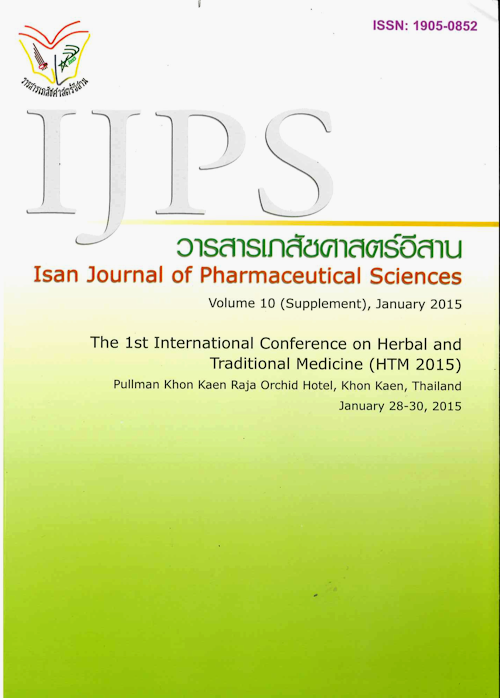Rambutan (Nephelium lappaceum) Seed Flour Prepared by Fat Extraction of Rambutan Seeds with SC-CO2
Main Article Content
Abstract
consumption to fruit canning industry. This seed waste contains high amounts of fat (14-41%) and
carbohydrate (28-46%). After fat removal, the defatted material could be potentially used as a fl our
alternative for food applications. The aim of this study was to produce fl our from rambutan seeds by
fat extraction with SC-CO2. The defatted fl our obtained was characterized by some selected properties
and evaluated for potential toxicity following acute oral exposure in rats. Methods: Fat was extracted
from ground rambutan seeds by SC-CO2 at 350 bar and 45 °C. Defatted fl our samples were determined
for proximate compositions, amylose content, paste viscosity by using RVA and evaluated for acute
oral toxicity. Results: Ninety percent of the total rambutan fat was extracted by SC-CO2, comparable
to that of hexane extraction. Defatted rambutan seed fl our had high contents of protein (10.07%),
carbohydrate (87.04%) and amylose (32.16%). Fat extraction resulted in higher RVA viscosity pattern
and exhibited no pasting peak with continual rise in viscosity. Compared with other sources of fl ours,
the defatted rambutan seed fl our exhibited much lower RVA viscosity pattern, suitable to apply in
confectionery formulation. This fl our material was non-toxic at 15000 mg/kg in acute oral toxicity
testing. Conclusion: SC-CO2 was capable of removing 90% of total fat available in rambutan seeds.
Defatted rambutan seed fl our contained high protein and carbohydrate, similar to those of all purpose
wheat fl our. Fat removal of rambutan seeds using SC-CO2 extraction produced a fl our exhibiting higher
viscosity determined by RVA and continual rise in pattern throughout the RVA cycle. However, the
viscosity pattern of defatted rambutan fl our was lower when compared with rice and wheat fl ours. The
oral acute toxicity showed that the defatted rambutan fl our was safe for consumption. Based on our
results, the defatted rambutan seed fl our could potentially be used as a food ingredient in development
of confectionery products.
Article Details
In the case that some parts are used by others The author must Confirm that obtaining permission to use some of the original authors. And must attach evidence That the permission has been included
References
AACC. Approved Methods of the American Association of Cereal Chemists. 10th ed., American Association of Cereal Chemists, St. Paul, MN; 2000.
AOAC. Offi cial method of analysis. 16th ed., Association of Official Analytical Chemists; Arlington, VA; 2000.
OECD. OECD Guidelines for Testing of Chemicals: Acute Oral Toxicology. Guideline No. 423; 2001.
Eiamwat J, Pengprecha P, Tiensong B, et al. Fatty acid composition and acute oral toxicity of rambutan (Nephelium lappaceum) seed fat and oil extracted with SC-CO2. Proceedings of the 5th International Conference on Natural Products for Health and Beauty, 2014 May 6-8; Phuket, Thailand.
Ng KF, Abbas FMA, Tan TC, Azhar ME. Physicochemical, pasting and gel textural properties of wheat-ripe Cavendishbanana composite flours. IFRJ 2014; 21(2): 655-662.
Phanthanapratet W, Trangwacharakul S, Wanlapa S, et al. Application of rambutan seed flour for low calorie salad dressing product. Agricultural Sci. J. 2012; 43 Suppl 2: 517-520.
Reverchon E, Macro IDe. Supercritical fluid extraction and fractionation of natural matter. J. of Supercitical Fluid 2006; 38: 146-166.
Sirisompong W, Jirapakkul W, Klinkesorn U. Response surface optimization and characteristics of rambutan (Nephelium lappaceum) kernel fat by hexane extraction. LWT – Food Science and Technology 2011; 44: 1946-1951.
Solís-Fuentes JA, Camey-Ortíz G, Hernández-Medel MDR, Pérez-Mendoza F, Durán-de-Bazúa C. Composition, phase behavior and thermal stability of natural edible fat from rambutan (Nephelium lappaceum) seeds. Bioresource Technology 2010; 101: 799-803.
Taggart P. Starch as an ingredient: manufacture and implication. In: Elliason AC, editor. Starch in Food. England: CRC Press; 2004: 363-392.
Thai Agricultural Standard. Thai Hom Mali Rice. Guideline No.: TAS 4000-2003. Available from: http://www.acfs.go.th/standard/download/eng/Thai_Hom_Mali.pdf
Yanty NAM, Marikkar JMN, Long K, Ghazali HM. Physicochemical characterization of the fat from red-skin rambutan (Nephelium lappaceum) seed. J. Oleo. Sci. 2013; 62(6): 335-343.
Yoswathana N. Optimization of supercritical carbon dioxide (SC-CO2) extraction of rambutan (Nephelium lappaceum) seed oil using surface response methodology. IJCEA 2013; 4: 187-190.


